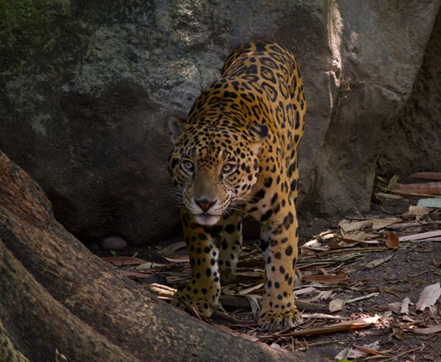The Jaguar (Panthera onca) is one of the most frequently encountered images in Mesoamerican art and iconography, in either naturalistic, stylized, or anthropomorphic form. Art is one of the ways in which people represent how they conceive of themselves, and their place in the world The appearance and frequency of jaguar motifs, as with any animal motifs, is not arbitrary but is centered on the symbolic systems which use the motifs metaphorically to express qualities regarded as significant for a given society, and within particular contexts (Saunders, 1994).
For The Mayan Culture the jaguar –called Balam- has been a symbol of life and is associated with the regenerative power of nature and the fertile land; an attribute of politician power, rector of time, lord of the night, and ruler of the underworld (Valverde, 2004). Even the main edification in the biggest city of the Classic Maya Period, Tikal, is represented by this amazing animal and called “The Great Jaguar Temple”.
But the jaguar is not only significant for its cultural value, but it is also important for the ecosystems because of its contribution to the ecological balance. Being at the top of the food chain helps to regulate different animal populations that it feeds with like peccari, deer, coatis, armadillos, birds, snakes, monkeys, tapirs, etc. The jaguar can also hunt young manatees, otters, and even crocodiles. Due to the power of its bite, it can shatter the shells of river turtles and on lonely beaches, he goes out to look for sea turtles, when they lay their eggs in the sand. Jaguars also avoid contact with humans, so there have been documented just a few cases of attacks on humans. However, humans have -indeed- contributed to the decline of their populations in areas where forests have been cut down to become livestock areas, affecting their habitat and generating a shortage of food; in addition to hunting, trading, and trafficking of their skins.
During the 20th century, hunting for their fur caused the species to almost disappear. The United States was responsible for most of the jaguar trade, importing more than 23,000 jaguar skins in 1968 and 1969 alone. With jaguar populations plummeting even in remote regions of the Amazon jungle, policymakers banned the big felines from international trade in 1975. In Guatemala, the main threats are direct hunting, illegal hunting of prey, forest fires, and most importantly the destruction and transformation of habitat due to the expansion of agricultural activities and livestock in protected areas and community forests.

The conservation efforts to protect the jaguar in the country are the designation of 33% of the national territory as protected areas of some kind, within which the Maya Biosphere Reserve in Petén, represents the biggest forest block; and more research plans. In addition, Panthera, an international organization dedicated exclusively to the conservation of felines, has proposed a new initiative called: The Jaguar Corridor Initiative, which seeks to protect jaguars throughout their range (from Mexico to Argentina). To achieve this ambitious challenge, they work together with local and international actors, such as non-governmental organizations, government entities, scientists, and communities to connect and protect sites with populations of jaguars within landscapes dominated by human beings. This Corridor is also important for other species because the jaguar is considered an “umbrella species” which means that that they need large expanses of natural habitat and connectivity to move around and that its conservation contributes to the natural balance of the species they interact with like we said before. Guatemala gives a special connection as a “bridge” between Honduras and Belice.
Now we know how important is this feline for the ecosystems and how it was for a whole culture through many years, that’s why November the 29th has been recognized as the day to commemorate and celebrate the Jaguar. Our children and family project Mayan Toons together with Panthera and ASOGUAMA (Asociación Guatemalteca de Mastozoologos) are commemorating “Jaguar Month” on its 3rd edition. You can play, share and learn with the educational material that Mayan Toons created here:
Our traditional game “lotería”
The book “Morita la guardarecursos”
Let’s share this helpful information to create awareness for its conservation!
BIBLIOGRAPHY
- n.d.
- Jaguar, Tigre de montaña. Ficha técnica.www.cich.org/publicaciones/09/Jaguar.pdf
- 2019
- Panthera y la Iniciativa del Corredor del Jaguar: el reto de conservar grandes felinos en un paisaje cambiante. Revista Mesoamericana de Biodiversidad y Cambio Climático, No. 6, Vol. 3. Read online:
www.revistayuam.com/volumen-3/panthera-y-la-iniciativa-del-corredor-del-jaguar-el-reto-de-conservar-grandes-felinos-en-un-paisaje-cambiante/ - 2011
- Los jaguares de la Reserva de la Biósfera Maya: Información para guías de turismo. WCS-Programa para Guatemala. Available online:
www.caftadr-environment.org/wp-content/uploads/2016/04/Jaguares-de-la-Reserva.pdf - 1994
- Predators of culture: jaguar symbolism and Mesoamerican elites. World Archaeology, 26(1), 104–117.
- 2004
- Balam: el jaguar a través de los tiempos y los espacios del universo maya. 1. ed. Ciudad Universitaria, México, D.F.: Universidad Nacional Autónoma de México, Instituto de Investigaciones Filológicas, Centro de Estudios Mayas.
First posted, November 2020
Note by Vivian Hurtado, FLAAR Mesoamerica (Guatemala).

